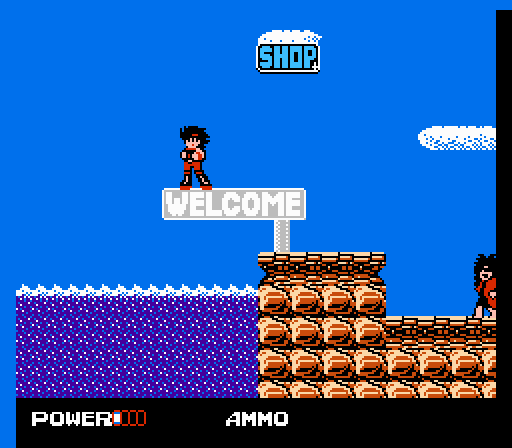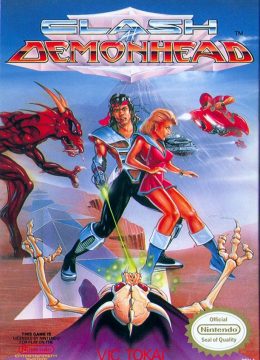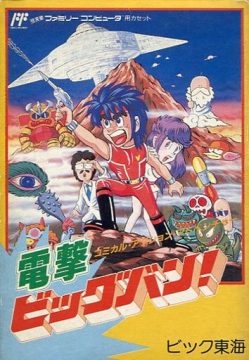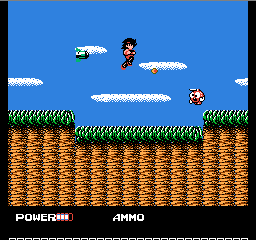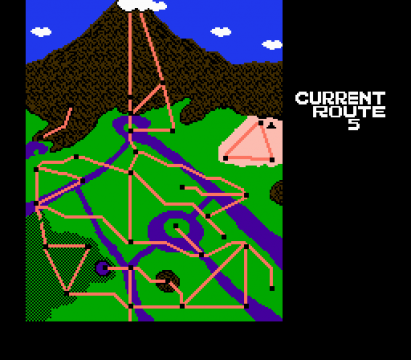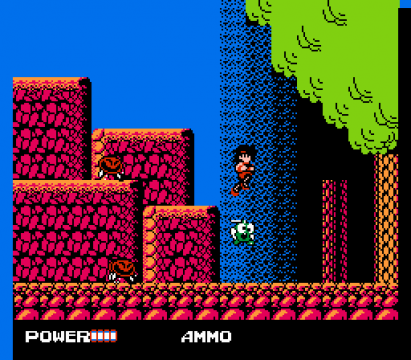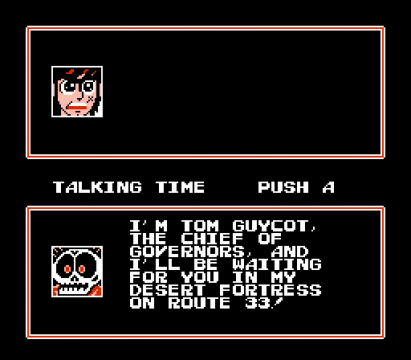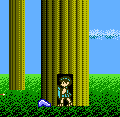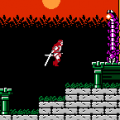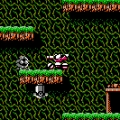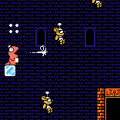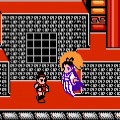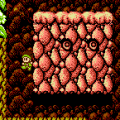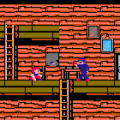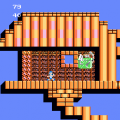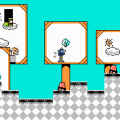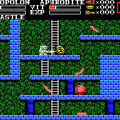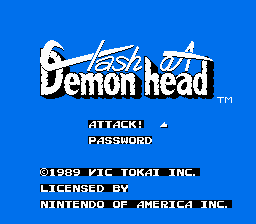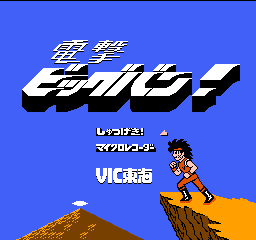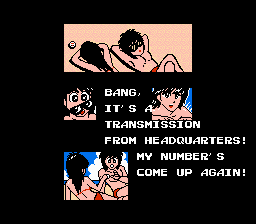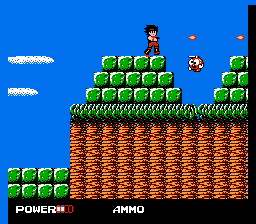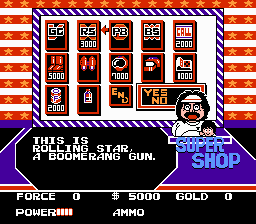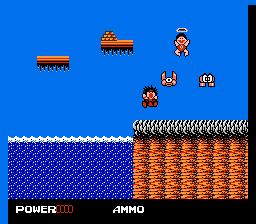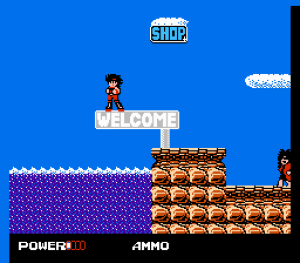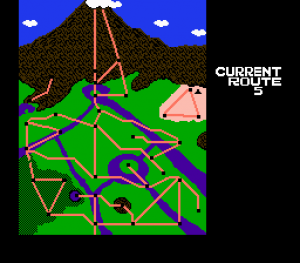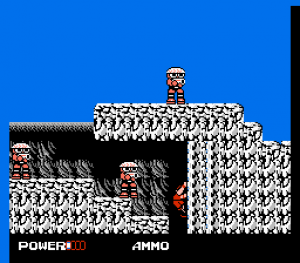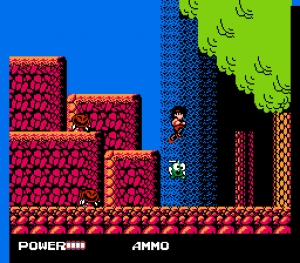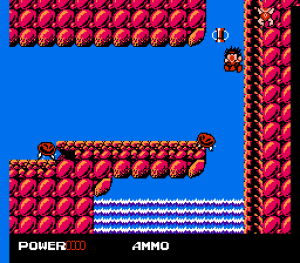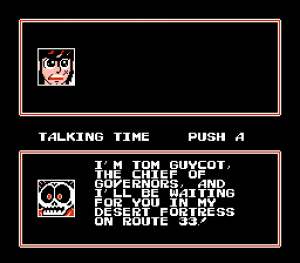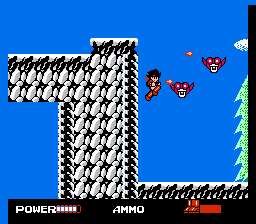Vic Tokai’s Clash At Demonhead is a rather unassuming game. You might think by the cheesy prog-rock style title and busy, airbrush- painted cover art, featuring a beefcake in metal armor and a radically dressed, short-skirted vixen, that Demonhead is in the vein of pulpy sci-fi schlock from the 1970s. Turn the NES on, though, and the game’s Japanese origins become apparent from the first cutscene with wide-eyed characters that wouldn’t look out of place on a cover of Shonen Jump.
Chances are Clash at Demonhead will sound unfamiliar outside of a passing reference in the Scott Pilgrim comics and movie. That’s okay. Demonhead wasn’t exactly a smash hit when it came out. But there’s a good reason the title has become more than just interesting movie trivia. While a clunky platformer in the moment-to-moment gameplay, Demonhead is a wildly ambitious game featuring a large world to explore, charming and often offbeat writing, and tons of hidden secrets and Easter eggs that make the game worth going back to again and again.
Clash at Demonhead opens with a cutscene, where main characters Bang and Mary are relaxing on a beach after having finished their last mission. They’re secret agents, though the intro doesn’t disclose what organization they’re a part of. The manual calls the group “Sabre Tiger”, while the back of the box refers to it as being the “Special Assault Brigade for Real Emergencies” (S.A.B.R.E.). Neither version is ever mentioned in the game proper. Regardless, their time off is cut short when Mary’s communicator begins to go off. It seems that Professor Plum, the creator of the appropriately named Doomsday Bomb, has been kidnapped, and is being held captive at a secret base inside of the titular Demonhead.
Narratively, Demonhead wears its spy movie inspiration on its sleeve, with its story of a lone soldier sent to retrieve a VIP from a rogue nation, borrowed from various James Bond movies and films of similar vintage. Visually, however, Demonhead borrows much more heavily from Japanese media than the American cinema its plot is inspired by. The character designs are clearly modeled after the same sci-fi anime that the creators grew up on, with big hair, facial scars, and exaggerated character expressions. Similarly, the world of Demonhead is vibrant and colorful, with mountainous vistas, bright green pine trees, and clear waters which pop from bright, deep blue backgrounds and pure white clouds overhead.
When the game begins, the player is transported to a large, zoomed out map of the island where the mountain Demonhead resides. Numerous paths branch off in different directions, and small, white nodes clearly mark where each path branches off, sometimes in as many as four different directions. Bang’s position is represented by an icon of his head at the bottom by the shoreline, presumably his point of entry to the island. When you enter the area, Route 1, Bang drops in from the top of the screen as the first enemies immediately begin bounding toward him.
This first impression is fairly accurate of the early game; enemies are relentless and placed fairly haphazardly around the map. It’s not nearly as bad as many other incompetent NES platformers, and this is mitigated somewhat by the lack of knockback when damaged and fairly lengthy invincibility frames. Still, don’t expect a lot of breathing room. What’s worse is that Bang starts with just four bars of health, though a bar represents more health than just one hit (though the exact amount is also unclear). This is upgradable as the game goes on, but the lack of care put into enemy placement, plus the fairly inscrutable nature of the game’s open design, means that first time players may get frustrated and quit before seeing all that the game has to offer.
And the game offers a lot – at the end of Route 1 is a small statue of a demon head. Once touched, it brings you back to the map screen, only this time Bang’s placement has moved to indicate the player’s progress. Additionally, they’re now able to make a choice using the B button; they can either move on to assorted other Routes or head back the way they came. The only real indication of a goal at this point comes from the intro (find Professor Plum), and from Tom Guycot, a caped skeleton who accosts you on Route 1 to tell you that he’s scattered the seven medallions necessary to disarm the Doomsday Bomb. Where those medallions are and how to find them is left to the player’s devices, or possibly a quick internet search.
Traversing the world of Demonhead isn’t enabled by upgradable abilities like traditional Metroidvanias. Instead, all of Bang’s movesets and upgrades can be found via the Super Shop, a store that sells a variety of helpful items such as the Aqua Lung, which stops the damage from being underwater, and Hyper Boots, which increase his run speed and jump height, and even a Jet Pack for free-formed flight. All of these abilities run off of non-refillable fuel, but multiple can be purchased and will be automatically equipped once the current supply runs out. Nicer still is that the game remembers how much fuel you had left on a single item. Other useful Super Shop choices include weapon upgrades; Ultra Food, which refills a single bar of health; and a microrecorder, needed to get a password. Money is easy enough to get, so health items and necessary equipment aren’t hard to come by, and losing all of Bang’s health only punishes the player by losing some money.
There are a couple of drawbacks to the shop, however, the biggest being that it’s located only at the end of Route 5. This is mitigated by the Shop Call item, which allows the store to be summoned down from any Route – provided the player can afford it. Fortunately, shop calls are fairly low in price and the player starts with one, so theoretically it’s possible to always use these and never visit the shop’s actual location. Anticipating this, the designers threw in a rather obnoxious wrinkle – the items you can purchase at the shop are randomized. There’s no guarantee that a vital shop call charge won’t go wasted when you can’t buy a much-needed Jet Pack, or that those always important Ultra Foods you need to complete a boss fight aren’t for sale.
Speaking of the bosses, called “Governors”, they are scattered about on different Routes inside of hard-to-miss buildings, and are usually guarding some plot-vital character or an item needed to complete the game, such as the aforementioned medallions. These battles come in two flavors, insultingly simple or a brutal war of attrition. The latter type first requires memorizing a pattern before looking for very small openings to land an attack.
Perhaps the biggest reason why Clash at Demonhead is well remembered is just how dang weird it is. It’s fairly obvious early on that the game doesn’t take itself seriously, with names like “Professor Plum”, “Doomsday Bomb”, or that the main villain is a cape-wearing skeleton named Tom. The game has a fair number of gags, too. NPCs shout “No!” in a comic book style speech bubble when you shoot at them, and talking to them takes place on a separate black screen labeled “Talking Time”. A certain NPC has a tragic death scene, which is given full narrative weight, until you leave the screen and try talking to them again, where Bang will keep telling them to hang in there as their corpse goes through various stages of decay each time they come back.
Despite the number of idiosyncrasies like weird physics, frustrating boss fights, relentless enemies, lack of guidance, and random shop items, it’s hard not to love the game. Combined with a bright art style and a quirky sense of humor, there’s a reason Clash at Demonhead is still worth checking out today.
